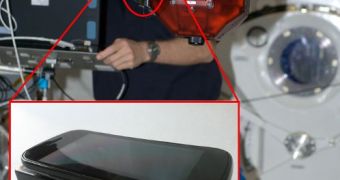Astronauts living and working aboard the International Space Station may soon get an entirely new type of assistants, which will help them carry out work during spacewalks, and also monitor their performances from afar.
The technology used to create these assistants was tested aboard the orbital lab this November. The volleyball-sized machines are called Synchronized Position Hold, Engage, Reorient Experimental Satellites (SPHERES).
The original design for these satellites was augmented with a Samsung Nexus S™ smartphone, running the open-source Android™ platform developed by Google. The handset received only minor modifications before being attached to SPHERES.
These satellites are entirely self-contained units, and can fly within the ISS without posing any type of threat to astronauts or equipment. They contain onboard power, propulsion, computing and navigational software, and are entirely self-sufficient as long as batteries lasts.
By adding the Samsung Nexus S™, NASA turned the free-flying robots into so-called Smart SPHERES. The devices now contain a small, energy-efficient computer within each unit, which allows them to compile basic calculations of data provided by their cameras and sensors.
Experts with the NASA Human Exploration Telerobotics project could not use the smartphone as a controller in its off-the-shelf configuration, so they needed to modify it to some extent. However, none of the modifications is major.
They simply switched the batteries from Li-Ion to AA alkaline, and then removed the GSM cellular communications chip, in order to prevent potential interferences with the complex electronics aboard the station.
During the November tests, astronauts had no difficulties collecting motion data from the SPHERES using the smartphone controller. This means that the machines could soon be used to conduct interior station surveys and inspections.
In time, NASA plans to expand the functionality of these robots, so that they can perform more complex tasks, and even fly outside the station. The small satellites would help Mission Control monitor astronauts and their performances from previously-impossible-to-attain vantage points.
“The tests that we are conducting with Smart SPHERES will help NASA make better use of robots as assistants to and versatile support for human explorers – in Earth orbit or on long missions to other worlds and new destinations,” says Terry Fong.
The NASA official is based at the Ames Research Center, in Moffett Field, California, where he is the project manager of the Human Exploration Telerobotics project and also the director of the Intelligent Robotics Group.

 14 DAY TRIAL //
14 DAY TRIAL //